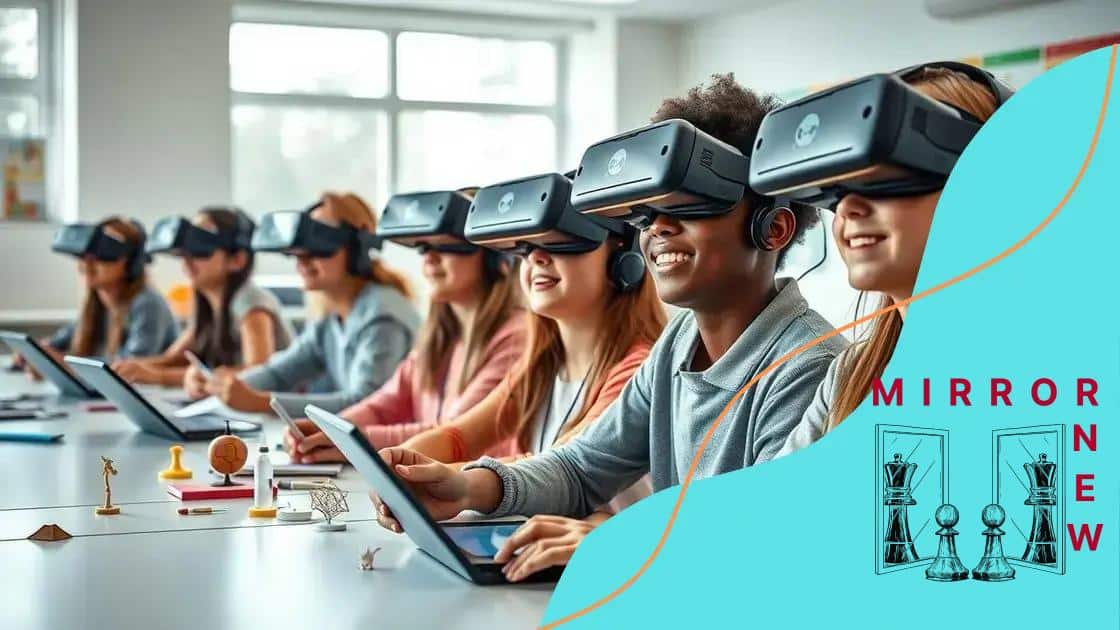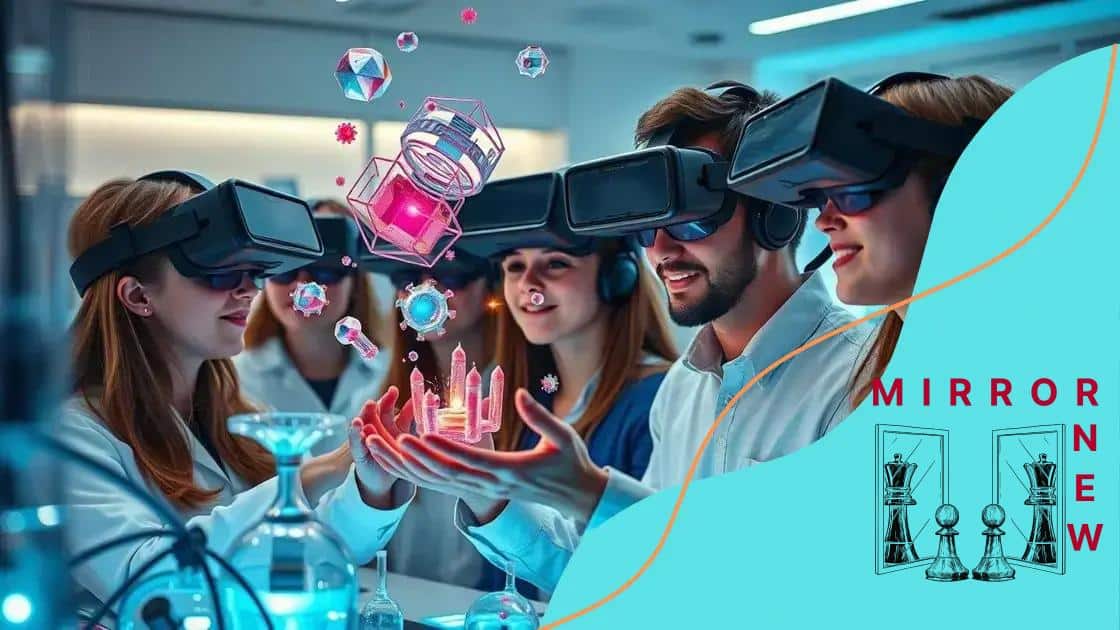Virtual reality labs for enhanced stem learning

Virtual reality labs enhance STEM learning by providing immersive, hands-on experiences that engage students, improve understanding of complex concepts, and foster collaboration in real-world applications.
Virtual reality labs for enhanced STEM learning are making waves in education. Imagine students stepping into a digital world where complex concepts come to life! This captivating approach not only makes learning fun but also deepens understanding. Curious to see how this model can transform education?
What are virtual reality labs?
Virtual reality labs are innovative spaces that utilize virtual reality technology to enhance learning experiences. These labs enable students to immerse themselves in three-dimensional environments where abstract concepts become tangible and engaging.
The primary purpose of a virtual reality lab is to provide a hands-on approach to education, especially in STEM subjects. Students can explore everything from the human body to distant planets, all from the classroom.
Key Features of Virtual Reality Labs
There are several essential features that make virtual reality labs effective:
- Immersive Learning: Students feel as though they are part of the lesson.
- Interactive Experiences: Users can manipulate the environment and objects within it.
- Real-World Applications: Lessons can simulate real-life scenarios for practical understanding.
With virtual reality, students can engage in complex subjects like physics, where they can visualize forces and motion in real time. It allows for greater exploration of difficult topics, making learning both fun and effective.
Benefits of Virtual Reality Labs
One of the most significant benefits of virtual reality labs is their ability to enhance student engagement. When students can interact with educational content, their motivation to learn increases. They are no longer passive receivers of information; they become active participants.
Furthermore, these labs foster collaboration among students. Working together in a virtual space can enhance teamwork skills while tackling challenges and projects. This also helps to build relationships and improve communication among peers.
As technology advances, the potential for virtual reality labs in education will continue to grow. With the right equipment and curriculum integration, these immersive environments can revolutionize how students learn and understand science, technology, engineering, and mathematics.
Benefits of using virtual reality in STEM education
The use of virtual reality in STEM education offers numerous benefits that can enhance the learning experience for students. This technology provides a unique way to visualize complex topics and engage students in a tangible manner.
One notable advantage is increased engagement. When students step into a virtual environment, they often become more involved in their learning. Instead of passively listening to lectures, they actively participate in simulations and exercises that make the material relevant.
Exploring Real-World Applications
Virtual reality allows students to explore real-world applications of the concepts they learn in class.
- Hands-On Learning: Students can conduct virtual experiments in physics or chemistry labs without the risks associated with real-life labs.
- Historical Experiences: They can walk through historical sites or observe significant events, making history come alive.
- Scientific Exploration: Students can explore the ocean depths or space, gaining insights that textbooks cannot provide.
Moreover, virtual reality fosters collaboration among students. In a virtual lab, they can work together on projects, allowing them to share ideas and learn from each other. This approach strengthens their teamwork skills and promotes interpersonal connections that are essential in any career.
Improved Understanding of Complex Concepts
Another key benefit is the ability to improve understanding of complex STEM concepts. Visualizing intricate systems and processes helps students grasp difficult ideas more easily. For example, in a biology class, they can observe cell division or ecosystems in immersive detail.
This method of learning has been shown to increase retention rates. When students engage with the material in an interactive way, they are more likely to remember what they learned. The impact of immersive learning can be profound, leading to better academic performance.
As education technology continues to evolve, integrating virtual reality into STEM curricula can prepare students for future careers in a world that increasingly relies on technology. Virtual reality not only enhances individual learning experiences but also helps shape the future of education.
How virtual reality enhances hands-on learning

Virtual reality (VR) significantly enhances hands-on learning by providing immersive environments where students can practice skills and concepts in real time. This experience allows for interactive learning that goes beyond textbooks and lectures.
One primary way VR enhances learning is through simulations. Students can engage in realistic scenarios that mimic real-world challenges. For instance, in medical training, students can perform virtual surgeries. This practical experience helps build confidence and competence.
Benefits of Virtual Simulations
Using virtual simulations offers several advantages:
- Safe Environment: Students can make mistakes without real-world consequences.
- Immediate Feedback: Learners receive instant feedback on their actions, allowing them to adjust and improve.
- Repetitive Practice: Students can repeat exercises, which helps solidify their understanding.
Furthermore, VR allows for collaborative hands-on experiences. Students can work together in virtual labs, experimenting with different strategies to solve problems. This builds teamwork and communication skills, which are essential in STEM fields.
Hands-on learning in virtual reality also accommodates various learning styles. Visual learners benefit from seeing concepts in action, while kinesthetic learners engage in physical activity as they manipulate virtual objects. This adaptability can lead to better retention of information.
Real-World Applications in STEM
VR can take students on field trips to places they might not otherwise visit. For example, they can explore outer space, dive into the ocean, or visit ancient civilizations. Such experiences can spark curiosity and foster a love of learning.
As technology advances, the applications of VR in education will continue to grow. Incorporating this tool into hands-on learning will not only modernize teaching methods but also prepare students for future careers where technology plays a crucial role.
Integrating virtual reality into classrooms
Integrating virtual reality into classrooms transforms traditional teaching methods and enhances student learning. This innovative approach offers immersive experiences that captivate students’ attention and encourage them to participate actively in their education.
One effective way to integrate VR into the classroom is by incorporating it into specific subjects. For example, in a history lesson, students can ‘visit’ ancient civilizations through a VR headset. Instead of reading about these cultures, students experience them firsthand, which deepens their understanding and retention.
Methods of Integration
There are several strategies educators can use to introduce virtual reality:
- Curriculum Alignment: Align VR content with the existing curriculum to ensure it complements learning objectives.
- Professional Development: Provide training for teachers on how to effectively use VR technology in their lessons.
- Collaboration: Work with tech companies or educational organizations to access quality VR resources that fit educational needs.
Additionally, incorporating VR in group activities promotes collaboration. Students can solve problems together in a virtual environment, developing their teamwork skills while engaging in hands-on activities. This social interaction is crucial for building communication skills.
Challenges and Solutions
While the benefits of virtual reality are numerous, educators may face challenges in implementation. One common issue is access to technology, as not all schools have the necessary equipment. To overcome this, schools can seek grants or partnerships with technology firms to acquire VR tools.
Another challenge is ensuring that the VR content is age-appropriate and enhances learning. Teachers can curate resources that meet educational standards, ensuring that the experiences are not just entertaining but also educational.
As technology in education continues to evolve, integrating virtual reality into classrooms opens new avenues for learning. It encourages creativity and critical thinking among students, making education more engaging and enjoyable.
Future trends in STEM education with virtual reality
As we look to the future, virtual reality is set to revolutionize STEM education in exciting new ways. This technology is not just a passing trend; it is reshaping how students learn and interact with complex concepts across science, technology, engineering, and mathematics.
One significant trend is the rise of collaborative virtual environments. Students from different locations can work together on projects in a shared VR space, promoting teamwork and enhancing their problem-solving skills. Imagine a group of students remotely exploring the surface of Mars together, analyzing geological features in real-time.
Advancements in Technology
As technology advances, VR experiences become more realistic and accessible. The quality of graphics and simulations continues to improve, making learning even more engaging. Here are some noteworthy advancements:
- Enhanced Interactivity: More interactive simulations allow students to experiment and see the effects of their decisions instantly.
- Affordable VR Solutions: With advancements in technology, VR equipment is becoming more affordable, allowing schools to implement these tools more easily.
- Mobile VR: Smartphones can be utilized for VR learning experiences, making it accessible to a wider range of students.
Another emerging trend is the integration of virtual reality with artificial intelligence. AI can personalize the learning experience, accommodating different skill levels and learning speeds. For example, a student struggling with a concept can receive immediate, tailored assistance while navigating a complex VR scenario.
Expanding Access to Quality Education
The use of VR in education also helps break down barriers. Students in remote or underserved areas can access high-quality STEM programs that may not be available locally. Virtual field trips to laboratories, research centers, or historical sites can provide invaluable experiences that inspire future careers.
The future of STEM education with virtual reality looks promising. By embracing these advances, educators can create immersive and engaging learning environments that foster curiosity and innovation in students. As virtual reality continues to evolve, its role in shaping the next generation of learners becomes ever more vital.
FAQ – Frequently Asked Questions About Virtual Reality in STEM Education
What are the main benefits of using virtual reality in STEM education?
Virtual reality enhances engagement, provides hands-on experience, and allows for immersive learning, making complex concepts easier to understand.
How can virtual reality help with collaboration among students?
VR enables students to work together in a virtual environment, facilitating teamwork skills and shared problem-solving without geographical limitations.
Is virtual reality technology accessible for schools?
Yes, advancements in technology are making VR tools more affordable and accessible for educational institutions, allowing broader implementation.
What kinds of subjects can benefit from virtual reality integration?
STEM subjects like science, technology, engineering, and math benefit greatly from VR integration as it allows students to visualize and interact with complex topics.





